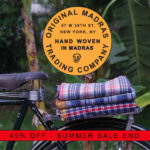
When it comes to certain things, you just don’t want to know how they’re made. Madras, however, isn’t one of them, as its creation is pretty interesting. The following is a 2011 interview with Cape Madras cofounder Brian Sisselman, who provided these wonderful photos of madras being made in Southeast India, and tells us how your favorite summertime fabric is made.
* * *
IS: Tell us about the company’s origins.
BS: Cape Madras started with the idea of creating the best madras in the world. Most madras comes from “supermarket” suppliers in the garment districts of India. My wife and I started in 2005 and spent two years in development learning about madras and finding weavers who could produce our fabric and colors.
Our business started in women’s apparel but from day one we thought our primary customer would be men. Now after seven years we are finally targeting men with Bermuda shorts, pants and shirts in short and long sleeve, and soon we’ll be delivering ties and sport jackets.

IS: How is your madras produced?
BS: To weave the highest-quality madras, we went to a small village in Tamil Nadu in Southeast India, the birthplace of madras, that’s been producing the fabric for over 100 years. Not the easiest route, but the one that would make our madras fabric stand out. We found out that the best madras comes from drying the yarns in fields with temperatures over 110 degrees at midday.
For sewing, at first we used factories in the cities but were disappointed in the quality. Going back to the weaving village, I found a group of tailors who had been commuting four hours every day by bus to work in sewing factories in the city. I decided to open a sewing shop in the village. Tailors are now able to stop commuting, work in their own village and spend more time with their families. And the quality they produce is superior to the factories in the city.

IS: You’re not modest about your quality.
BS: We make our madras using superior 100% combed cotton, 40/40s yarn, and increasing reeds and picks in the weaving process. We create all our yarns and dry them in the hottest time of the year. The weaving is done on power looms dating back 60 years.
Before we pick complementing colors in all our patchwork fabrics, we create hundreds of sample swatches on bit looms. With these 10-inch squares we build the color patterns for the patch fabrics we ultimately make into garments.
After all the fabrics are woven, we patch the fabrics and start the cutting and sewing process. We do all this in the same small village to insure the people have a commitment to quality from the yarns to the finished product. We do everything but plant the cotton seeds.

IS: What about bleeding madras? Was that always really a vice recast as a virtue?
BS: Well said. Colors back in the bleeding madras days came from vegetable dyes that would not hold their color to the yarns. The colors were limited: blue, dark red, burgundy, browns. From the beginning we wanted to modernize the old traditional madras colors, and without the limits of vegetable dyes we can offer an unlimited palette of colors.
IS: Where are you based?
BS: Cape Elizabeth, Maine. The business has grown out of our basement, and through the beauty of technology I can SKYPE with the weavers and tailors any time. Separated by 8,000 miles on this planet, but brought together with computers. The world really is flat.
IS: What do you like most about this fabric?
BS: If it shows signs of wear and tear, it only it looks better. I know this might not mean a lot to most people, but for me the search to make the best madras has helped define my life. I’ve met people who love to share stories of a madras shirt or dress that they still have in their closet. Like lines on a face, your madras will have stories to tell of where it’s been.

Photos:
1) Madras yarns dry in the fields at temperatures as high as 115 degrees. 2) An ox-pulled cart delivers yarns for dyeing. 3) Dyed yarns are taken to the field for drying. 4) After drying, yarns are made into thread on weaving looms. 5) This traditional 25-pound iron is filled with coal embers.










Nice article and I admire their devotion, but patch madras isn’t Ivy.
“FILL IN THE BLANK isn’t Ivy” could be applied to nearly anything on this site. If I opted to blog about the branch rather than the tree, this would be a boring site indeed.
Besides, I’m sure others will chime in to refute your assertion.
Do you happen to know if they offer periodic sales on their clothing?
Thank you, Christian.
@gregg: Patch Madras pants were featured in The Original Preppy Handbook – women’s pants and men’s swim trunks.
From Act 3 of “An Ideal Husband” by Oscar Wilde…….
“Fashion is what one wears oneself. What is unfashionable is what other people wear.”
…so it might be that Ivy is what one wears oneself. What isn’t Ivy might be what other people wear…..
Lord Goring is my favorite literary dandy.
i’d love a madras shirt, but they’re practically never made in colors that work with my skin tone! =(
Like Wilde said, “Either that madras goes, or I do.” And we know what happened to him.
Baker: LOL!
This is a must for those fond of Wilde such as myself : http://www.amazon.com/Picture-Dorian-Gray-Annotated-Uncensored/dp/0674057929/ref=sr_1_1?ie=UTF8&s=books&qid=1306880471&sr=1-1
And what about their sales, Christian?
I can see the reason for annotation, but what about uncensored? Have we all been reading bowlderized editions?
As for Cape Madras sales, Hilton, I have no idea. You’ll have to send them an email. Small niche companies like that generally don’t do much discounting, though. Time to be a tad less parsimonious.
The ‘bleeding’ aspect of Madras was its unique selling point.
Take that away and you may as well buy check fabric from anywhere IMO.
From what I understand, it was a selling point only because marketers had to come up with a way to explain why the dyes wouldn’t hold.
“Guaranteed to bleed” became the slogan.
But many purists consider the bleeding stuff The Real Deal.
You’ll hear from one tomorrow.
i wouldn’t want madras that bled. i look terrible in faded colors. on the other hand, i do understand why some people would want bleeding madras since it looks better on them, and they are probably the primary market.
I’m glad that Cape Madras appears to be both successful & responsible. I do wish, though, that they offered non-patch options. I just don’t care for patch anything, madras or otherwise.
Authentic bleeding madras would be nice, too, because faded colors (some of them, anyway) do complement my skin tone.
Bleeding Madras colors tended to run and create all sorts of weird and wonderful new colors rather than to fade……
interesting article. and enlightening so to speak.
Beautiful photos and a really interesting article.
I dont know of too many companies making bleeding madras nowadays.I bought some bleeding madras fabric at patchwork-madras.weebly.com , and it was good quality.
Good for light summer madras shirts.
That first picture is beautiful. And I love the ox with bedecked horns!
I hold this guy’s devotion to quality in high esteem. I love when people truly get back to the roots in sourcing and quality, and know precisely where everything they’re working with comes from. My only quibble is the casting of bleeding madras as merely well-marketed inferiority. First of all, and I may be wrong, but I thought all madras used to be vegetable-dyed, and it was just a particularly unstable batch with the “musty, pungent smell of vegetable dyes and gingelly oils” and “brilliant colours,” marketed to compensate by BB in 1958, that made it mainstream (Richard Press attests to his family selling it far before then). Either way, I think the limiting of colors to “blue, dark red, burgundy, browns” has the same charm and beauty as ancient madder. I don’t see any value in “modernizing the old traditional madras colors.” Furthermore, I must say I was very excited by his marketing, but rather let down when I looked on his site. While others dislike patchwork madras, I hold no such prejudice, and it is rather the garish colors and factory-looking perfection that I dislike. (I also think patchwork madras is easy to do wrong, and making it look too deliberate or color-coding it is an easy way to do that.) Madras’s beauty and esteemed place in the “Ivy canon” (which is just to say its common appearance on campuses in the heyday) is predicated on some degree of imperfection, texture, and softening. Otherwise it becomes a neon eyesore I dislike for the same reason I do the ’80s over-the-top, rainbow preppiness.
I agree with Wayne Kerr: without the imperfections (bleeding colors and visible slub created by short-staple cotton), I see no reason to prefer it over those “summer plaid” fabrics styled after madras that you can find in any Walmart.
But I fully agree with this gentleman that, “If it shows signs of wear and tear, it only it looks better [sic]” and that, “Like lines on a face, your madras will have stories to tell of where it’s been.” Sanitizing it and standardizing it only hinders that, no?
IvyBird- Very astute take on Madras. My teenage years were in the 1960’s when bleeding madras was king. I still have a collection of madras, including shirts and trousers from O’Connell’s new/old stock, shorts, belts, and a tie or two. Your comment about lines on a face and well worn madras are spot on. I’ve got 70 years under my belt with lines on my face and some faded, well worn madras. Hopefully around for a while longer.
I want to reinforce Mike S in quoting the source of Prep madras approval and a staple of prep wear. However, I do draw the line on the patch madras jackets etc. Madras is ‘busy’ enough to see, add the complexity of the patches and you may suffer eye damage.